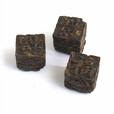Olive Oil
Although the olive tree originated in Asia, it has been cultivated for over 3,000 years in Mediterranean countries, where much of the olive crop is used to make olive oil. In this process, olives are pitted and ground to a thick pulp. The pulp is then pressed to remove the juices, which are placed in a centrifuge to separate the water from the oil. Nutritionally, olive oil contains 120 calories and 14 grams of fat per tablespoon; however, the fat is mostly monounsaturated, which has a beneficial effect on blood cholesterol levels and is easily digested. In countries where olive oil plays an important role in diets, such as Greece, Italy and Spain, there is a low incidence of cardiovascular disease. The mild vegetable mucilage in olive oil also protects the body's digestive tract. Ancient civilizations used olive oil, as well to help heal wounds. Today olive oil is prized as a moisturizer and skin remedy.
Therapeutic Effect
Taken internally, olive oil stimulates metabolism, promotes digestion and lubricates mucous membranes. It can also be applied externally to treat dry skin.
Components
Olive oil contains 77% monounsaturated fatty acids, 14% saturated fatty acids and 9% polyunsaturated fatty acids, plus vegetable mucilage and Vitamin E.
Help For The Digestive Tract
Take 1 tbsp, of olive oil on an empty stomach to stimulate digestion and relieve upset stomach, flatulence and heartburn.
Olive Oil For Constipation
In the morning, take 1 tsp of olive oil mixed with lemon juice on an empty stomach. Or try an enema made from 5 oz. of olive oil in 20 oz. of boiling water, cooled to lukewarm.
The Antioxidant Benefit
The Vitamin E in olive oil is an antioxidant. In addition, monounsaturated fatty acids are less easily damaged by oxygen than other types of fat. They are therefore less likely to produce free radicals, which damage cell membranes and contributes to several diseases.
APPLICATIONS
To Lower Blood Cholester
The monounsaturated fatty acids in olive oil help lower LDL ("bad") cholesterol levels without affecting HDL ("good") cholesterol or triglyceride levels. To lower cholesterol at least 15% of your daily calories should come from monounsaturated fatty acids. Whenever possible, use olive oil in place of butter or other vegetable oils in cooking, in preparing dressings for salads or vegetables and in making sandwiches.
To Treat Ear Complaints
To clear stopped-up ears, put a few drops of lukewarm olive oil in the affected ear. Lie for 5 mins on the opposite side, then turn over, so that the olive oil can flow out again. (Caution: Do not put any liquid in your ear if you think you may have a perforated eardrum!) For minor earaches, soak a cotton pad in olive oil. Place it loosely in your outer ear until the pain abates.
To Prevent Hair Loss
Massage your scalp with olive oil every evening for eight days. Let the treatment work overnight; wash out in the morning.
To Moisturize Skin
Apply daily to dry spots or stretch marks.







